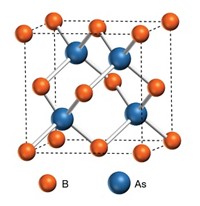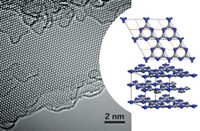Advertisement
Grab your lab coat. Let's get started
Welcome!
Welcome!
Create an account below to get 6 C&EN articles per month, receive newsletters and more - all free.
It seems this is your first time logging in online. Please enter the following information to continue.
As an ACS member you automatically get access to this site. All we need is few more details to create your reading experience.
Not you? Sign in with a different account.
Not you? Sign in with a different account.
ERROR 1
ERROR 1
ERROR 2
ERROR 2
ERROR 2
ERROR 2
ERROR 2
Password and Confirm password must match.
If you have an ACS member number, please enter it here so we can link this account to your membership. (optional)
ERROR 2
ACS values your privacy. By submitting your information, you are gaining access to C&EN and subscribing to our weekly newsletter. We use the information you provide to make your reading experience better, and we will never sell your data to third party members.
2-D Materials
Borophene could have impressive electronic and physical properties
Theoretical new material bests graphene by some measures, but critics wonder if it can be made
by Sam Lemonick
February 7, 2019
| A version of this story appeared in
Volume 97, Issue 6
A computational study has predicted a new 2-D boron material with impressive electronic and physical properties (J. Am. Chem. Soc. 2019, DOI: 10.1021/jacs.8b13075).
Chemists first predicted borophenes—the boron equivalent of graphene—in the 1990s, but the materials weren’t synthesized until 2015. Borophenes share graphene’s sought-after mechanical and electronic properties, but boron’s lower mass makes them lighter. Unfortunately, boron can’t form stable honeycomb structures the way carbon can in graphene.
Li-Ming Yang of Huazhong University of Science and Technology and colleagues predict a new material composed of sheets of borophene sandwiching a layer of tetracoordinate aluminum atoms to stabilize the boron honeycombs. The team’s calculations suggest that this three-layer material would be stiffer than single-layer graphene and would remain stable when heated to nearly 2,100 K. And the researchers say their borophene could be a superconductor at 4.7 K and as high as 30 K when the structure is strained. Such superconducting properties could be useful in electronics, transportation, or energy storage.
Those superconducting values may be optimistic, says Boris Yakobson, a computational chemist at Rice University. He points out that under different assumptions, models suggest lower temperatures. He also thinks borophene wouldn’t survive the strain needed to improve its superconducting temperature. He and others say the biggest assumption is that this material can be made. But Alexander I. Boldyrev, a computational chemist at Utah State University who has collaborated with this group before, says they’ve successfully synthesized other materials they’ve predicted.




Join the conversation
Contact the reporter
Submit a Letter to the Editor for publication
Engage with us on Twitter